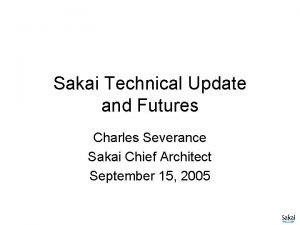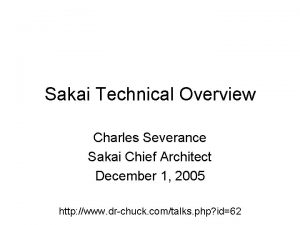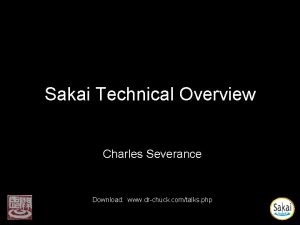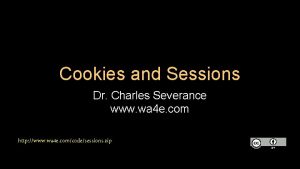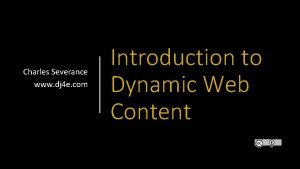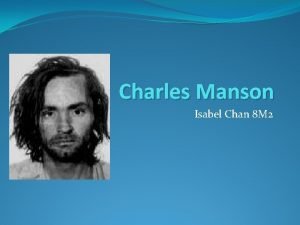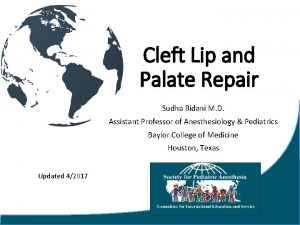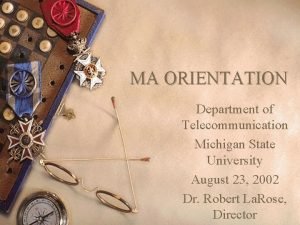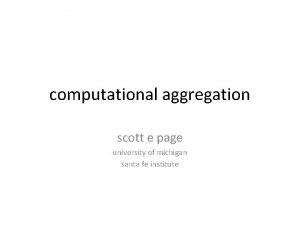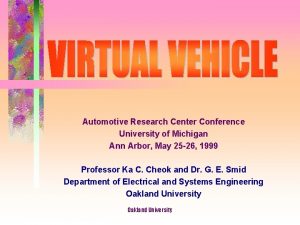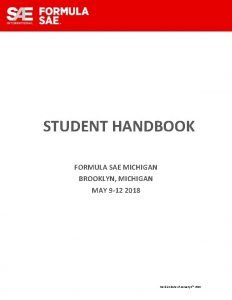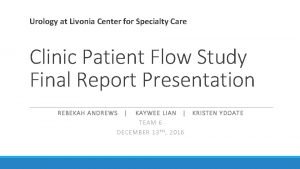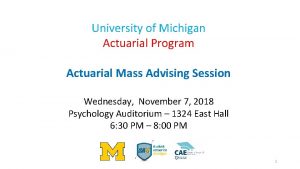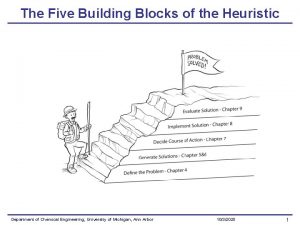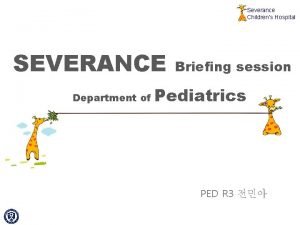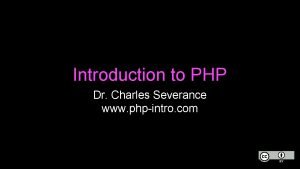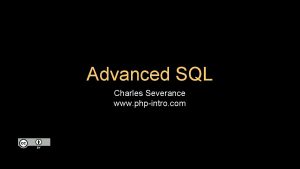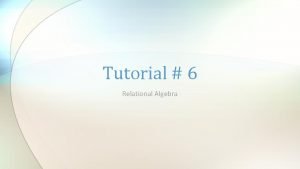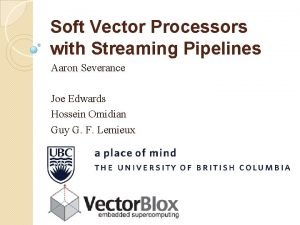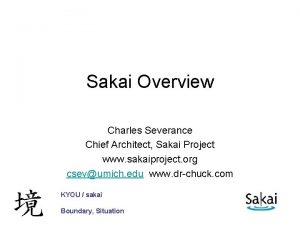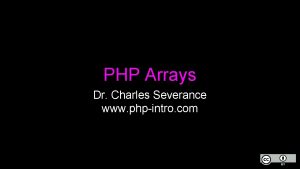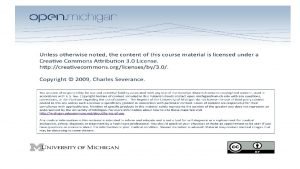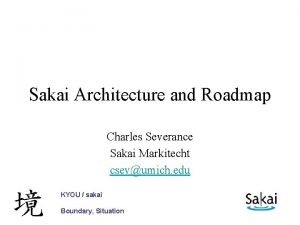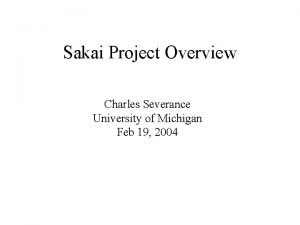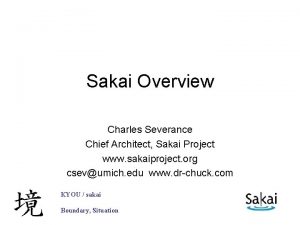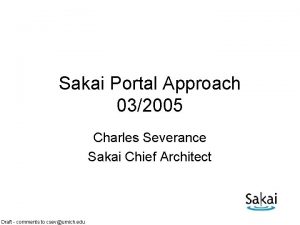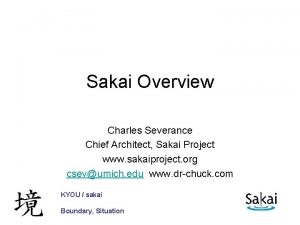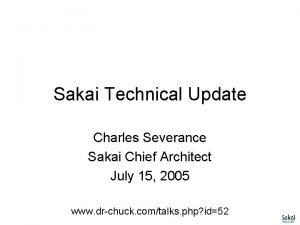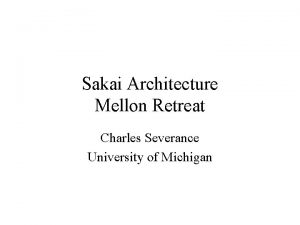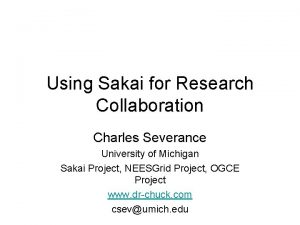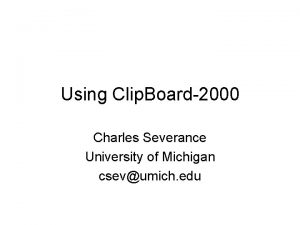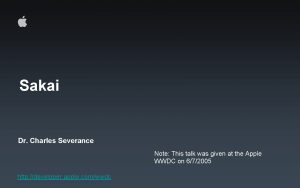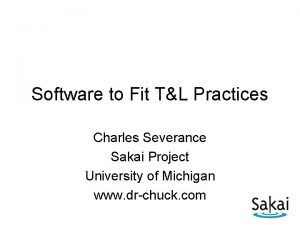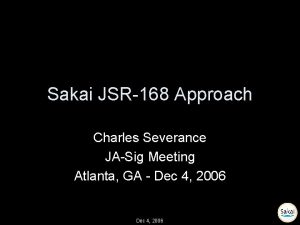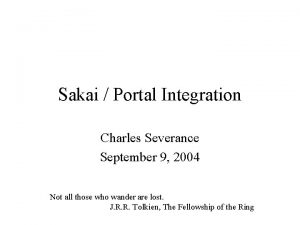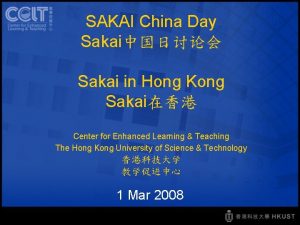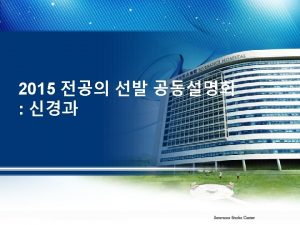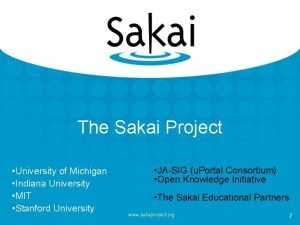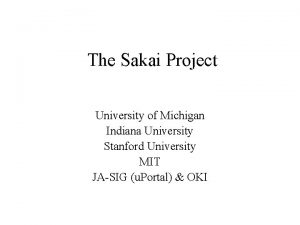Sakai Architecture Charles Severance University of Michigan SAKAI
























- Slides: 24

Sakai Architecture Charles Severance University of Michigan

SAKAI Basics • U Michigan, Indiana U, MIT, Stanford, u. Portal – All have built portals / course management systems – JSR-168 portlet standard requires us all to re-tool and look at new approach to portals • Course Management System Standards – Open Knowledge Iniative (OKI) needed full implementation – IMS standard such as Question and Testing Interoperability (QTI) – SCORM Course Content Standard • • Why not coordinate this work , do the work once, and share each others solutions? Integrate across projects and adopt relevant standards Collaboration at the next frontier - implementation Tool Portability Profile (TPP) – Truly portable tools and services – Tools built at different places look and feel the same and share data and services – This is difficult - Interoperability is harder than portability • Mellon Foundation funding

Sakai Organization • To some, the real innovation is the organization • To get these schools/institutions to adopt a central authority (Sakai Board) for resource allocation of internal as well as grant resources • Goes beyond resources from grant • Required for closely coupled open source development, the ‘seed’ software? • Part of the open source experimentation

Secret plan: Someday, I see my masterpiece come to life! Web Lecture Archive Project www. wlap. org Tools And Technologies Lecture Object

Board Joseph Hardin, UM, Chair & Project Manager Brad Wheeler, IU, Vice Chair Jeff Merriman, MIT-OKI Amitava ’Babi’ Mitra, MIT- AMPS Carl Jacobson -JASIG Lois Brooks, Stanford Technical Coord. Committee Chair Chuck Severance Tools Rob Lowden Architecture Glenn Golden u. Portal Stanford MIT U of Michigan Indiana Univ. Local Members u. Portal Stanford MIT U of Michigan Indiana Univ. Local Teams

Open/Open Licensing • “. . all work products under the scope of the Sakai initiative for which a member is counting matching contribution and any Mellon Sakai funding” will be open source software and documentation licensed for both education and commercial use without licensing fees. Significant difference between a “product” and a “component” Unlimited redistribution is an important aspect of a license.

SAKAI Overview July 04 Jan 04 May 05 Activity: Maintenance & Transition from a project to a community Michigan • CHEF Framework • Course. Tools • Work. Tools Indiana • Navigo Assessment • Eden Workflow • Oncourse MIT • Stellar Stanford • Course. Work • Assessment OKI • OSIDs Dec 05 SAKAI 1. 0 Release • Tool Portability Profile • Framework • Services-based Portal • Refined OSIDs & implementations SAKAI Tools • Complete CMS • Assessment SAKAI 2. 0 Release • Tool Portability Profile • Framework • Services-based Portal SAKAI Tools • Complete CMS • Assessment • Workflow • Research Tools • Authoring Tools Activity: Ongoing implementation work at local institution… u. Portal Primary SAKAI Activity Architecting for JSR-168 Portlets, Refactoring “best of” features for tools Conforming tools to Tool Portability Profile Primary SAKAI Activity Refining SAKAI Framework, Tuning and conforming additional tools Intensive community building/training

Sakai Deliverables • Tool Portability Profile - A book on how to write Sakai-compliant services • Tool Functionality Profile - A book on the features of the Sakai-developed tools • Sakai Technology Release - O/S LMS – Sakai Technology Framework – Sakai Tools and Services – Integration, QA, and Release Management

Portability Profile Components • Tools – JSF Faces GUI Layer – JSR 168 Portlet – JSR Servlet Standard • Services – Level 1 -3 Inversion of Control (dependency injection) – Spring, Pico, OKI, Avalon, Turbine, • Storage / Caching / Scaling – J 2 EE / EJB / Jboss - Stateless Session / Entity Beans – Hibernate (maybe) – Need to support RDF and URI across all services • This is in progress and evolving

Sakai Architecture Portal Configuration Implementations Portal Technology u. Portal 3. 0 JSR-168 Technology Legacy JSF GUI Portable code Sakai Service Layer Channels, Teamlets JSR-168 Portlets Sakai Portlet Sakai GUI Layer Mega-portable code CHEF Services OKI Services Sakai Services

GUI: Java Server Faces get…() set…() process. Action…() view Render Service API (OSID) tool_bean

Sakai: Thorny Issues • How to handle many repositories (Dspace, Fedora, JSR-170) though one API? • How to store information in a way that is both efficient/fast and flexible/reusable - perhaps RDF/URI is a unifying approach to finding and reusing content? • How to take the OKI APIs and add sufficient detail (out-of-band-agreements) so as to make it clear how to write tools? • How to make AUTHZ scalable, fast, portable, and interoperable?

Federated Interfaces OKI/Sakai Tool I Federated DR API Local DR API Fedora DR API … DSpace Fedora DSpace DR API DB

Use an Object Store? External Portfolio Tool RDF/URI DRAPI Object Store AUTHZ AUTHN

Use RDBMS? External Portfolio Tool RDF/URI DRAPI ? ? RDBMS AUTHZ AUTHN

RDBMS + “RDF” APIs External Portfolio Tool AUTHZ AUTHN RDF/URI DRAPI RDBMS Until we are sure based on development experience - this will be TBD - One thing for sure - we will not sacrifice performance for architectural elegance

“Out-Of-Band Agreements” Tool DRAPI Object Store AUTHZ AUTHN OKI does not specify many schema details for lots of objects to maintain flexibility. The OKI API leaves these details to be worked out between the tool developers and the OSID implementers. The Sakai project will decide on these schema-like issues and publish them. But dealing with schema’s directly is often painful and leads to thick and hard-to-modify tools….

Façade/Schema/Semantic Layer Tool org. sakai DRAPI AUTHZ Object Store AUTHN Sakai will define build convenience classes (facades …) which enforce semantic details of the Sakai out-ofband agreements on the OKI APIs. Not all OKI APIs will have facades, Applications will be able to communicate directly with the OKI APIs as necessary, the façade mapping may not always be one-to-one. Specs like IMS and LOM will influence these schema decisions within Sakai. The goal is to keep tools easy, clean, and portable. Because the façade classes use OKI APIs, they can move into non. Sakai OKI compliant environments.

Fast, Flexible, Portable, Modular AUTHZ And then a miracle happens…

Sakai 1. 0 Contents • Complete Framework including JSF to Portlet Rendering and JSR-168 u. Portal • All of the CHEF tools and services in legacy mode • Three new TPP compliant tools: Navigo (Assessment), DR Tool, and Gradebook(tbd). • Seamless look and feel between legacy and TTP-compliant tools • Complete Portability Profile “book” • Ready to deploy as LMS • Ready to use as a development platform with rich sample applications • Nearly complete implementation of OKI OSIDs, façade classes, and full interoperability with CHEF services

Sakai Milestones 2/15 Framework Technology (SFT) - Tech Preview 1 2/19 All Hands Workshop + Portability Profile (TPP) D 2 2/27 SEPP: SFT TP 1 + TPP D 2 + Tool Functionality (TFS) D 1 3/27 SFR Beta 1 + TPP Beta + TFS D 2 4/30 TFS D 2 + non-TPP Navigo Released 5/1 Sakai 1. 0 Beta 1 5/12 SEPP: Sakai Beta Final form except for partial TPP Navigo 6/15 SEPP: Workshop + Public Beta 7/15 Sakai 1. 0 Public Release CHEF Tools (12) + TPP Navigo + TPP tools (2) 8/15 Pilot efforts begin at partner institutions 9/1 Sakai 2. 0 Development Begins 6/1/2005 Sakai 2. 0 Released (many interim releases)

Sakai 2. 0 • Complete replacement of legacy tools – TPP Compliant, using OKI and Sakai APIs – Specs based on the TFS - tools will be richer and deeper – Each partner institution will focus on a set of tools to develop • SEPP partners will be involved in the new tool development based on ability and commitment.

Summary • We have a long way to go and a short time to get there… • The team we have assembled is the key - each institution brings deep and complimentary skills to the table • Previous collaboration (Navigo, OKI) over the past few years has developed respect, teamwork, and trust from the first day of Sakai • We are taking some time at the beginning to insure genuine consensus and that we truly make the right choices in the framework area. • We understand that we may make mistakes along the way and have factored this into our apprach and resource allocation. • So far everyone has had an open mind and understands the “good of the many…”

A Vision • We will create a open-source learning management system which is competitive with commercial offerings, but at the same time create a framework, market, clearinghouse, cadre of skilled programmers, and documentation necessary to enable many organizations to focus their energy in developing capabilities/tools which advance the pedagogy and effectiveness of technology-enhanced teaching, learning, and collaboration rather than just building another threaded discussion tool as a LMS.
 Charles severance sakai
Charles severance sakai Charles severance sakai
Charles severance sakai Severance télécharger
Severance télécharger Dr charles severance
Dr charles severance Dr charles severance
Dr charles severance Charles manson childhood
Charles manson childhood University of michigan
University of michigan Wmu msw application
Wmu msw application Michigan state physics
Michigan state physics Michigan state orientation
Michigan state orientation Scott page university of michigan
Scott page university of michigan University of michigan automotive research center
University of michigan automotive research center Sae michigan
Sae michigan Pareto clinic
Pareto clinic University of michigan actuarial science
University of michigan actuarial science Nine dot problem
Nine dot problem Severance children's hospital
Severance children's hospital Texas rrc permit query
Texas rrc permit query Severance intro
Severance intro Severance
Severance Company database schema
Company database schema Severance streaming
Severance streaming Severance téléchargement direct
Severance téléchargement direct Severance intro
Severance intro Severance network
Severance network
